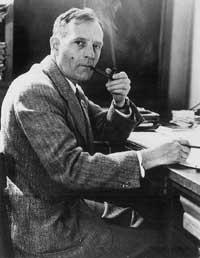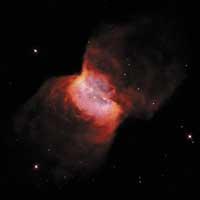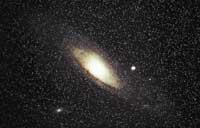Hubble: the man behind the telescope

By 1920, three galaxies of thousands of solar systems were known: ours, the Milky Way and the Big Cloud and the Little Magellanic One, the three at a glance. But also, there was another structure that could be seen at first sight: Andromeda nebula or dust cloud. Therefore, one of the greatest advances of the time was to discover that Andromeda was also a galaxy.
Hubble had the opportunity to work with the telescopes of Mount Wilson of California. With these telescopes, Hubble calculated that the Andromeda galaxy was far away, more than two million light years. “If being so far away you see it at first sight, it is a sign of the greatness of that galaxy,” he thought. Thus, they knew that Andromeda was four times greater than the Milky Way.

This forced to change the concept of the universe epoch, recognizing that, besides those they knew, other galaxies could exist. In addition, that meant that the universe was greater than they thought.
Little by little, Hubble was discovering galaxies further away from the Andromeda itself thanks to the large telescopes. As the telescopes improved, more structures were found in the sky than they did not see before. This led many astronomers to think that the universe could be infinite, that is, it had no end.
The Universe Becoming Bigger
It is evident that astronomy and cosmology were much advanced at that time. Well, one of the most productive advances was the use of the Doppler effect. And so they knew that the universe was expanding. Astronomers learned how to use the Doppler effect of the light of stars, since it can be known whether they approach or move away from Earth depending on the evolution of color.

Hubble also benefited from the Doppler effect and realized that the farther away a galaxy is, the farther away, that is, the relationship between speed and distance was linear. So, if the distance to galaxy A is twice as far as B, A is twice as fast as B. He tried to define a constant defining this relationship: the constant expansion of the known universe or the constant of Hubble. “The star’s color of light indicates whether that star is moving away or approaching, at what speed it is going and at what distance it is,” Hubble said.
Thanks to the Doppler effect they knew that most of the stars they saw in the sky were moving away. This gave much to think of astronomers. And, if we go back in time, at some point we begin to think that perhaps the whole universe is made. Being all the matter of the whole Universe accumulated in a single point, it is essential that conditions (temperature and pressure) exist on Earth that are not present.


In addition, someday the merged matter would begin to disperse. This caused that, on the one hand, the theory of the Big Bang and other hypotheses about the creation of the universe were raised, and on the other hand, the universe was believed to have an age. They calculated the age of the universe through the distance velocity of galaxies.
According to these calculations, the universe was born two billion years ago. This information was the subject of numerous discussions. In fact, geologists had calculated the age of the Earth (three billion years) and, of course, the Earth could not have been created before the universe itself. It was evident that some and others were wrong in making calculations.
Time showed that geologists were right and the most competent astronomers had to recognize that the universe was much older. Today, it is estimated that the universe is between 10 and 20 billion years old, according to the Big Bang theory. As techniques improve, as age becomes more concrete, we will approach the moment of the birth of the universe, but we will never know exactly. However, astronomers continue to look into the sky, seeking the origin of everything around us.





